Big Bend Blues: Chasing Quail Through the Desert With a 1-Year Old Puppy
An electrifying jolt shot through my leg like a bolt of lighting, and yet the air still crackled with dryness. We yearned for a storm to soften the West Texas elements, but more immediately a four-inch cactus spine lodged in my blood-soaked pant leg stung like crazy. It was the first of many of this wasteland’s formidable defenses. The spine that had pierced deep enough also penetrated my psyche otherwise preoccupied with the pervasive silence only broken by loose desert rocks trodden by weathered boots and the paws of a single-minded puppy.
The calendar had just turned, and the 2019-20 hunting season was winding down when I decided to cross the Lone Star State from my home in Austin in pursuit of better upland hunting opportunities. I’d spent countless days hunting grouse and pheasants up north before finally getting my own dog. But chasing bobwhites with a puppy during a down year can leave any hunter feeling cheated, and like any hunter I instinctually wanted to travel farther down the road less traveled, which took me all the way to the border of Mexico adjacent to Big Bend National Park.

They call it Big Bend after the curve of the Rio Grande in remote southwest Texas. For fans of arid and desert landscapes, and isolation, the place is a ruggedly beautiful natural region that encompasses about one-million acres of public land including Big Bend National Park and Big Bend Ranch State Park. You can hike there, ride horses, go off-roading and run rivers. I drove there for the scaled quail.
After all these years in pursuit of upland quarry, no other has fooled me as badly or as often as scaled quail. And, while the trip has become an annual tradition – one that becomes more familiar and fruitful year after year – nothing will ever top watching my first bird dog point and retrieve her first wild bird.
Pack It Up
I somehow convinced my friend, Mark, to sacrifice his cherished deer-hunting days and commit his hunting season to chasing birds with me. More than likely, he grew tired of hearing me talk about my new English setter, Sage, and wanted to shut me up. Either way, with a willing hunting partner and a dog backed by a year’s worth of work, I craved a real adventure.
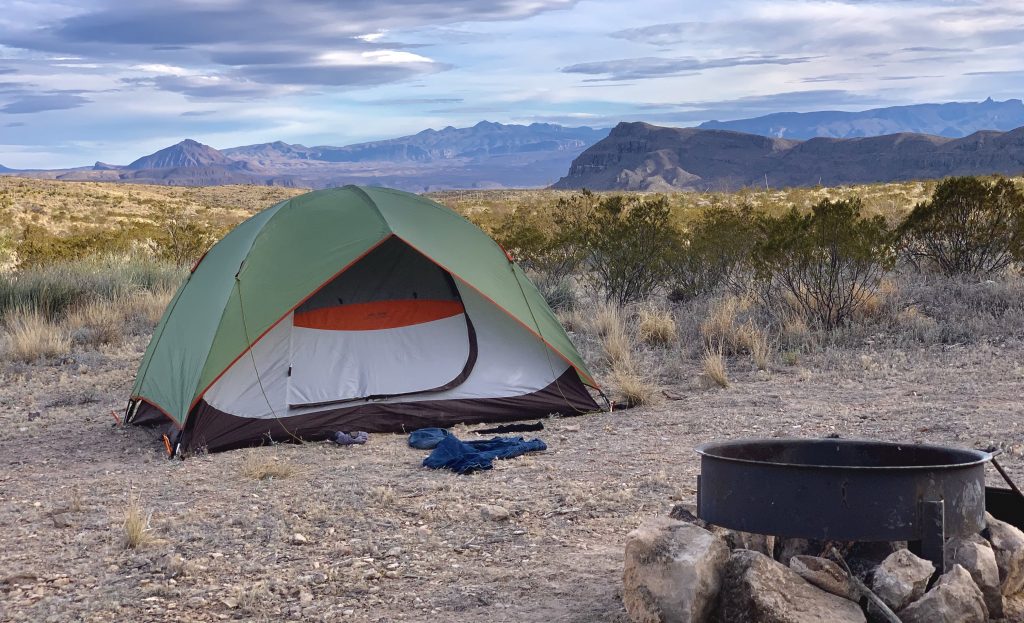
Big Bend naturally rings in the ears of Texas outdoors enthusiasts. It sits atop each of our bucket lists. Consequently, the neighboring Black Gap Wildlife Management Area had been on our hunting radar for quite some time. With late January theoretically providing us a shot at some decent weather, Mark and I devised a plan.
We agreed to camp four nights and hunt for three full days in true backcountry, giving ourselves ample time to self-educate, experiment and explore. Expectations were low given the season’s lack of success, but our tenacity reflected the significance of what would be the final hunt of the year.
We packed up my Toyota 4Runner, which was fit for the job with four-wheel drive, a 3-inch lift and 33-inch tires. But even with all the seats folded down, space was limited. Four nights of camping requires a lot of gear, particularly when you’re hauling in your own firewood, not to mention a crate with a dog in it.
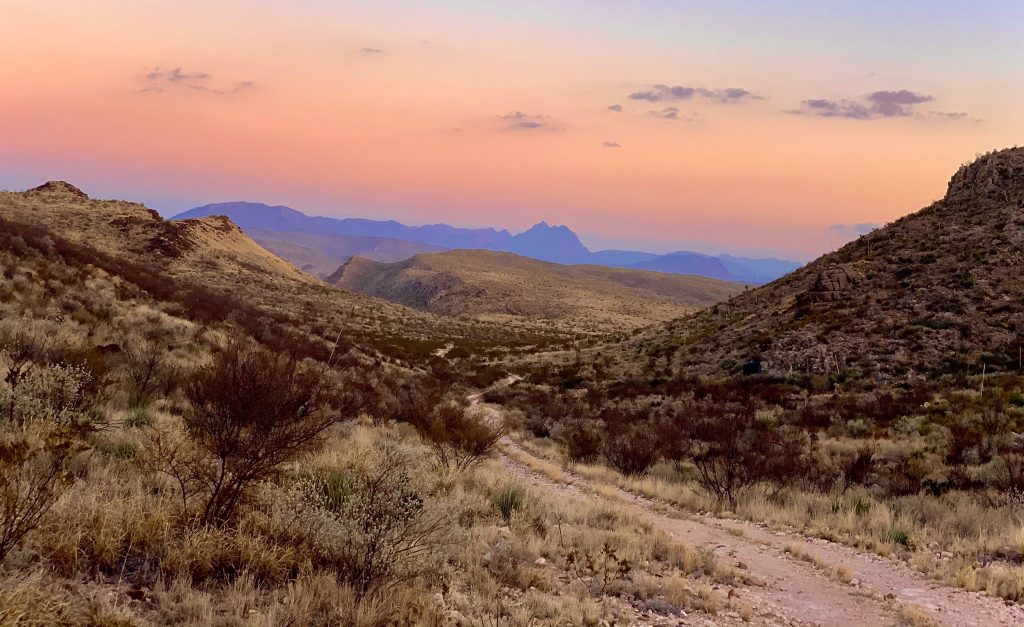
We drove for nearly nine hours from Austin to Black Gap, a trek that showcased some of Texas’ most breathtaking country. By 8 p.m. on a Thursday night, we were self-registering at the WMA’s entrance.
West Texas, Best Texas
It took us another hour or so to reach the place we’d eventually adopt as a campsite, but not before some legitimate rock crawling and a fair amount of technical maneuvering. However, the complete absence of sunlight would keep the waves of awe at bay until morning.
We set up camp, started our first fire and cracked a couple of beers to spark the ceremonial exchange of both doubt and optimism surrounding the days ahead.
Waking up was more than memorable; it was powerful. The air had a different taste: unseasoned and raw, but pure. The land was vast, but almost implausible. There was no one in sight – a much different scene than your typical public hunting parcel in Texas – and we wouldn’t actually see anyone until our second-to-last day.
We weren’t in big country; we were in God’s country. And, we had it all to ourselves.
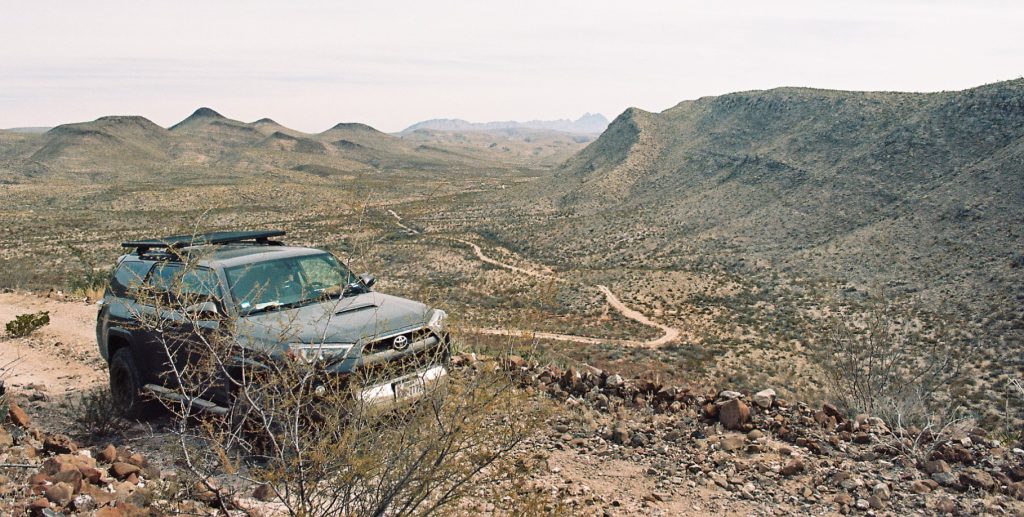
Laying Groundwork
These were uncharted waters for me. There were no blazing October aspens. No lone alder peaking out like a diamond in the rough. We scanned miles of mountains, cacti and wide-open spaces, all of which collectively pieced a collage of beauty scaled quail supposedly called home.
I’d never even seen one of these birds, and yet I was trying to act as a guide for Mark, who hoped only to lay eyes on a covey. Ideally, he’d witness some solid dog work, too.
Per usual, I placed my trust in Sage, whose instincts have trumped my intuition time and time again. But I’d soon find she, too, was out of her element in these parts. We spent hours putting miles behind us while Sage quartered ahead. Her training was holding true, but there was no way to know if she could remain interested for three days without moving a covey, let alone whether her body could withstand these harsh conditions.
I made a grave mistake when I forgot to bring boots for her, but lucked out in picking a puppy with more grit than any gunner I’ve ever met. Sage never slowed, powering through prickly pear cacti seemingly unfazed. She would only stop for the occasional cactus spine stuck in her paw, which she’d quietly bring to me for help.

Her drive motivated Mark and me both, as there was no way we could leave this place without paying her what she deserved: birds.
Somewhere in the middle of the first day, she locked up on point, finally with conviction. She’d shown signs of hope all morning, but this time it was clear she had no doubts. We slowly crept up behind her, recalling all the voices that had warned us of these birds’ inclination to run.
My eyes were scouring all the ground around a lone shrub next to a prickly pear, but Mark’s followed Sage’s dust-caked nose, which led them to a bird lying on its side beneath a mess of cactus paddles. It almost felt as if Mother Nature was throwing us a bone as a way to tip her cap at our determination. Or, maybe she just pitied our lack of knowledge. Whatever the case, our hunt had just scored hope, the universal fuel that drives hunters.
The bird appeared to have been shot and never recovered, but it definitely hadn’t been there long. So, we assessed the terrain, the elevation and, most of all, the cover.
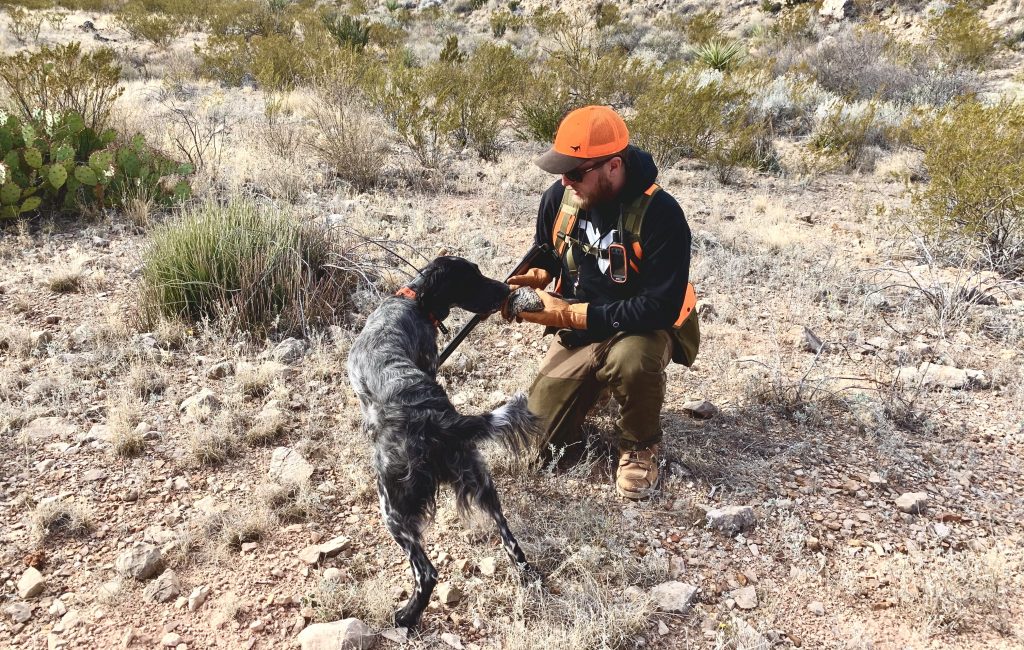
On our final run of the day, we decided to drive back toward camp where we remembered seeing some similar cover, a decision that instantly paid off. A covey of maybe 25 scaled quail raced across the road, showing off the athleticism of a roadrunner and the allure of Bigfoot. We took Sage and pursued on foot, but barely made it 10 steps in before the distant covey flushed toward the mountainside, presenting no kind of ethical shot.
Mark stayed on the ground with Sage, while I worked my way up the mountain attempting to push birds back down. Unfortunately, once birds started to flush, Sage couldn’t contain herself, chasing most of them far, far away.
I suppose you could call it puppy immaturity, but I felt as overzealous as she looked. With a forgiving exhale, I signaled her to come back, and decided to wrap it up as the sun fell behind jagged mountains. Mark lent the optimism you need on a hunt like this, reiterating the win that came from finally moving birds.

As we burned through our night’s worth of firewood (and a few well-deserved Budweisers), Sage caught up on her rest as we began scheming for the following morning. We learned a lot in a day of patience.
First, scaled quail don’t hold like bobwhite whatsoever. They’re fast as all get-out and they’re more skittish than a whitetail downwind during a tornado.
Second, we learned that they prefer the taller, thinner shrubs for cover, which was a huge advantage for us. You could pick out large pockets of green from miles away, an abundant color in each of our early covey sightings.
Third, they seemed to stay in low ground, but near steep mountains they could use for a quick retreat from danger.
And, finally, we needed to keep Sage from ranging too far. Unlike the first day, though, we had somewhere to start.
Lock and Load
The next morning we woke up with confidence. We had a better understanding of the cover, but more importantly, we knew there were birds. As soon as we started touring the circuit of hotspots we marked on the GPS, we saw another covey crossing the road. We essentially replayed the night before, chasing the desert phantoms aimlessly before realizing we were never even close.
About three hours later, we realized we’d made two crucial mistakes. Not only did we waste invaluable time by driving around hoping to stalk scaled quail on the run, but we also burnt through quite a bit of gas. And, we didn’t think to bring a spare gas can – a rookie mistake.
We had to trek an hour back across the desert and through the mountains just to get out of the WMA, and another 10 miles toward a one-pump gas station we’d heard about through only word of mouth. With loads of luck on our side, we found it, filled up and tried to salvage the daylight we had left.
By the time we got back to our honey hole, Sage was beside herself with angst, voicing her dismay about our poor planning. And, while we repaid her with at least 100 birds, we weren’t able to shoot a single one.
It was more trial and error, as we watched birds flush far away, frequently because Sage was too hot on a scent. As we were learning the birds’ tendencies, though, so was she.
We seemed to get closer and closer, but never close enough. We covered more miles in just half a day than I’d probably walked all season. We were pushing hard to finish the day strong, a tempo Sage never questioned. In fact, it might have been her resilience that truly set the tone. Despite our efforts, though, we would go into our third and final day of hunting empty-handed.
One More Chance
With only a day left, I had made peace with our results. We had seen more birds than I had ever seen on public land in a single hunt. Sage displayed immeasurable progress over the course of the trip, and her drive stoked the fire that sustains my obsession for the uplands.

It’s always been about her. The three-piece bond connecting gunners, dogs and birds comes to fruition long before a bird ever falls. However, despite her tender pads, quivering legs and winded lungs, I wanted to give her one more chance. I knew I had to limit her to one run, as her health will always take priority over this shared passion of ours.
We stayed close to camp this time, partly because we wanted to limit Sage’s walking, but also because the cover looked as good as anything else we’d eyed up throughout the week. With each step, I felt her digging deeper for strength, and myself regretting more and more the decision to let her hunt. Only moments before I would’ve called it, she went on the perfect point.
It felt like I was replaying the early days of her training when everything first clicked. I could see excitement in her eyes, but also a learned discipline that restrained her adolescent urge to get closer. She slowly stalked, I woahed.
There had to be birds. It was too perfect. Day three, her final hunt, the perfect point, failure, redemption? C’mon, man. There had to be birds.
Then, like I’d just pulled one of the “someday” fantasies from a catalog in the back of my mind, everything just fell into place. Sage’s reluctance to creep presented us the chance to get closer, the birds flushed perfectly, and I finally got a real shot. My trust in my dad’s old Citori and my favorite 7½-shotshells held up.

Sage and I finally got our first scaled quail, but more importantly, she got her first wild bird via a flawless sequence.
The only part I hated was having to make Mark watch as I reaped all the benefits of such a strong team effort. Few hunters have a guy who’s willing to commit that kind of time while forfeiting his own obsession. He deserved a bird as much as Sage did.
We crated Sage for the rest of the day, as I couldn’t in good conscience let her go on. So, Mark and I had to try and do this without a dog.
After basically a whole day without action, I started feeling guilty for leaving my four-legged partner behind. We weren’t seeing birds, and she cried hysterically every time we went on a run without her.
I eventually drove back to the camp, where I set Sage up on a nice soft bed so she could rest her body and watch Mark give it one more shot on his own. We’d spotted a big jackrabbit earlier that day, so he figured even if he didn’t bump a covey, he at least had a shot at coming back with a consolation prize.
As Mark walked out of sight, I still had a glimmer of hope, but it was flickering. Then, I heard a series of shotgun blasts reverberate between the mountains, a sure sign Mark had seen something.
Not long after, he came back with a crooked grin on his face, the tell-tale sign of a fellow hunter who’s about to rub it in. Sure enough, he’d shot not one, but two quail, representing the cherry on top.
Only wingshooters can interpret the relationship between man and birds with credibility, and it’s my belief they can only do so with a properly trained bird dog. But anyone with an affinity for upland hunting owes it to themselves to experience the endless pursuit of scaled quail.
Based out of Austin, Texas, David is an avid upland hunter who travels the country with his Old Hemlock English Setter, Sage, in pursuit of wild birds. His true passion lies in the art of developing bird dogs, drawing from George Bird Evans’ philosophy of training with a respect for the natural instincts of pointing breeds. David expertise in the field has led him to contribute articles to renowned hunting magazines for the past decade, guiding novice hunters both in the field and between the pages. Throughout October and January, you’re likely to find him chasing ruffed grouse in the Northwoods, pheasant in the plains, or quail in the desert with his father’s old 20-gauge Browning Citori.
Useful resources:
The National Park Service web site for Big Bend National Park
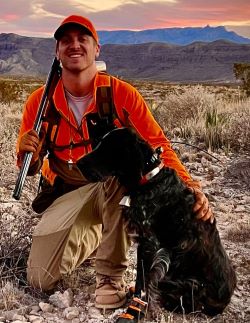
Based out of Austin, Texas, David is an avid upland hunter who travels the country with his Old Hemlock English Setter, Sage, in pursuit of wild birds. His true passion lies in the art of developing bird dogs, drawing from George Bird Evans’ philosophy of training with a respect for the natural instincts of pointing breeds. David expertise in the field has led him to contribute articles to renowned hunting magazines for the past decade, guiding novice hunters both in the field and between the pages. Throughout October and January, you’re likely to find him chasing ruffed grouse in the Northwoods, pheasant in the plains, or quail in the desert with his father’s old 20-gauge Browning Citori.


Comments